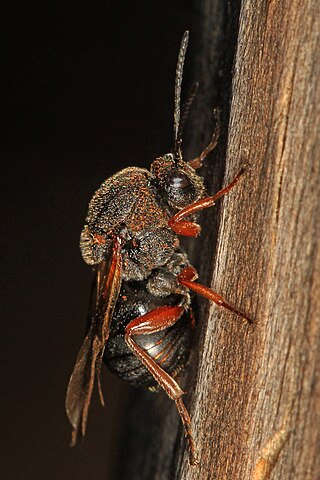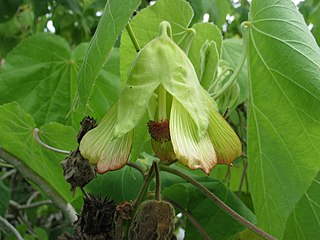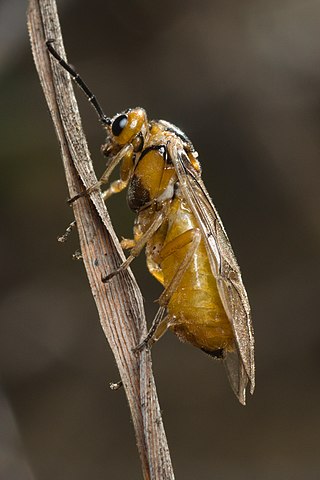
Galls or cecidia are a kind of swelling growth on the external tissues of plants, fungi, or animals. Plant galls are abnormal outgrowths of plant tissues, similar to benign tumors or warts in animals. They can be caused by various parasites, from viruses, fungi and bacteria, to other plants, insects and mites. Plant galls are often highly organized structures so that the cause of the gall can often be determined without the actual agent being identified. This applies particularly to some insect and mite plant galls. The study of plant galls is known as cecidology.

Gall wasps, also incorrectly called gallflies, are hymenopterans of the family Cynipidae in the wasp superfamily Cynipoidea. Their common name comes from the galls they induce on plants for larval development. About 1,300 species of this generally very small creature (1–8 mm) are known worldwide, with about 360 species of 36 different genera in Europe and some 800 species in North America.

A gall-inducing insect is any insect that can cause the growth of galls within plants. There are several groups of insects that meet this description. They include the gall wasps, scales, gall midges, aphids, psyllids and certain species of leafminer flies.

Abutilon sandwicense, commonly known as the greenflower Indian mallow, is a species of flowering plant in the mallow family, Malvaceae, that is endemic to the island of Oʻahu, Hawaii, in the United States. It inhabits dry forests on the slopes of the Waiʻanae Range at elevations of 400–600 m (1,300–2,000 ft). Associated plants include lama, ēlama, māmaki, kalia, āulu, olopua, and alaheʻe. Greenflower Indian mallow is a shrub, reaching a height of 1.5–3 m (4.9–9.8 ft). It is threatened by habitat loss.

Nesopupa is a genus of very small air-breathing land snails, terrestrial pulmonate gastropod mollusks in the subfamily Nesopupinae of the family Vertiginidae.
Nesopupa oahuensis is a species of very small, air-breathing land snail, a terrestrial pulmonate gastropod mollusk in the family Vertiginidae, the whorl snails. This species is endemic to Hawaii in the United States.

Euphorbia haeleeleana, the Kauaʻi spurge, is a species of flowering plant in the croton family, Euphorbiaceae, that is endemic to the islands of Kauaʻi and Oaʻhu in Hawaii. Like other Hawaiian spurges it is known as `akoko.

Sapindus oahuensis is a species of tree in the soapberry family, Sapindaceae. It is endemic to Hawaii, where it is limited to Kauaʻi and Oʻahu. Its common names include Āulu, Oahu soapberry, alulu, kaulu, and lonomea.

Quercus lusitanica, commonly known as gall oak, Lusitanian oak, or dyer's oak, is a species of oak native to Portugal, Spain and Morocco. Quercus lusitanica is the source of commercial nutgalls. These galls are produced by the infection from the insect Cynips gallae tinctoriae. They are used for dyeing.

Eriococcidae is a family of scale insects in the order Hemiptera. They are commonly known as felt scales or eriococcids. Each species is usually specific to a different plant host, or closely related group of hosts.

Lobelia oahuensis is a rare species of flowering plant in the bellflower family known by the common name Oahu lobelia. It is endemic to Hawaii, where it is known only from the island of Oahu. There are about 100 individuals remaining in the Koʻolau Range, and only one known individual in the Waianae Range. It is federally listed as an endangered species of the United States.

Cynipinae is a subfamily of gall wasps (Cynipidae). Many of the approximately 1,500 described species cause galls on oaks, but some induce galls on other plant species or are inquilines of the gall-inducing species. Species occur on all continents except Antarctica, with most found in the temperate regions of the northern hemisphere. All extant cynipid species are within Cynipinae since the only other recognized subfamily is Hodiernocynipinae which is based on the fossil genus Hodiernocynips.
Cicadulina is a leafhopper genus in the tribe Macrostelini.

Andricus quercuscalifornicus, or the California gall wasp, is a small wasp species that induces oak apple galls on white oaks, primarily the Valley Oak but also other species such as Quercus berberidifolia. The California gall wasp is considered an ecosystem engineer, capable of manipulating the growth of galls for their own development. It is found from Washington, Oregon, and California to northern regions of Mexico. Often multiple wasps in different life stages occupy the same gall. The induced galls help establish complex insect communities, promoting the diversification in niche differentiation. Furthermore, the adaptive value of these galls could be attributed their ecological benefits such as nutrition, provision of microenvironment, and enemy avoidance.

Euura is a genus of sawflies of the family Tenthredinidae, subfamily Nematinae. Some of the larvae feed externally on plants and some form plant galls on willows (Salix species). In the case of the gall-forming species, when the female lays her eggs she injects a stimulant and the gall start to form before the eggs hatch. Most sawfly galls are hard and individual larva tend to inhabit the gall, feeding on the tissue and leave the gall to pupate in the soil. Most of the species are monophages although the type species, Euura mucronata, is polyphagous feeding on over thirty species of willow.
Euura myrtilloides is a species of sawfly belonging to the family Tenthredinidae and the larvae forms galls on swamp willow. It was first described by Jens-Peter Kopelke in 1996. E. myrtilloides is one of a number of closely related species which is known as the Euura atra subgroup.

Fergusonina, the sole genus in the family of Fergusoninidae, are gall-forming flies. There are about 40 species in the genus, all of them producing galls on Eucalyptus, Melaleuca, Corymbia, and Metrosideros species in Australia and New Zealand.
Antistrophus is a genus of about 10 species of gall wasps. The genus is only known from the Nearctic. Species of Antistrophus induce galls on plant species in four Asteraceae genera: Silphium,Lygodesmia, Chrysothamnus, and Microseris.














